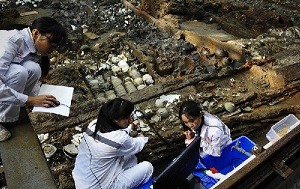Chinese archaeologists have announced on Saturday, Jan. 9, that they have recovered more than 14,000 relics from an ancient cargo ship salvaged in 2007 from a depth of 30 meters below the surface of the South China Sea, the Xinhua News Agency reported.
Liu Chengji, deputy head of the Guangdong Provincial Institute of Cultural Relics and Archaeology, said that most of the relics include porcelain products, such as pots, bottles, bowls and plates, produced by then famous kilns in places now known as Fujian, Jiangxi and Zhejiang.
The report said that as of Jan. 5, archaeologists have also excavated hundreds of gold, silver and copper relics and about 17,000 copper coins.
"The cargo composition of the vessel is clearer and the diversity is rich," said Liu at the Marine Silk Road Museum in Hailing Island of Yangjiang City, Guangdong. The museum was specially built to preserve the vessel.
The well-preserved ship, which was named "Nanhai No. 1," meaning "South China Sea No. 1," dates back to the early Southern Song Dynasty (1127-1279). The remains were about 22 meters long and 9 meters wide.
Liu said that some relics had the names of shops and places, which he believed showed the well-developed commercial economy during the dynasty.
"Some personal belongings, such as bracelets, finger rings and necklaces, were also discovered. These items showed the vessel had a certain number of merchants and passengers aboard," said Sun Jian, technical director of the Underwater Cultural Heritage Protection Center of the State Administration of Cultural Heritage.
Sun said that the ship, which was a short and fat model, was widely used in ancient times. It was designed with high safety standards, with the ability to resist waves and carry big freight load.
The report said that excavation inside the vessel will be completed in 2016.
In November last year, Chinese archaeologists have also unearthed more than 10 tons of ancient coins dating back to the West Han Dynasty (206 B.C. - A.D. 25) at royal tombs in Jiangxi Province.
It was reported that nearly two million copper wuzhu coins were excavated from the imperial tomb for the Marquis of Haihun State, near present-day Nanchang, estimated to be equivalent to 10 million yuan ($1,575,000) in the currency of that time.



























